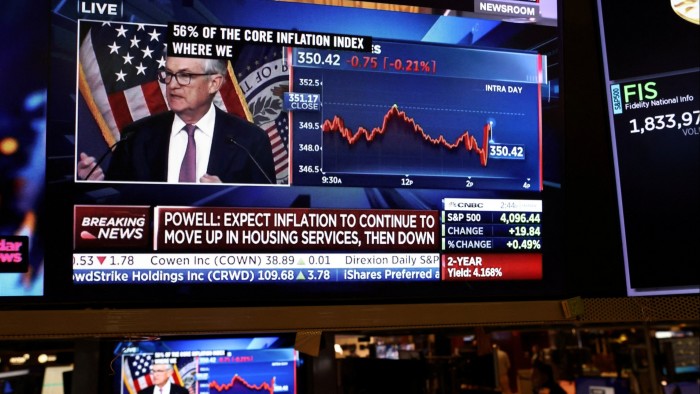The paradox of financial conditions


Roula Khalaf, Editor of the FT, selects her favourite stories in this weekly newsletter.
The writer is president of Queens’ College, Cambridge, and an adviser to Allianz and Gramercy
Last week was a lesson in central bank “unusual” — developments that are less common and deserve to be thought through carefully as they speak directly to the future wellbeing of the global economy.
I am talking here of two notable contrasts: first, larger differences in policy implementation among major central banks. Second, and more important, a notable variance between the latest signals from the US Federal Reserve and the financial conditions through which monetary policy delivers outcomes.
At Wednesday’s press conference that followed the announcement of a widely expected 25 basis point rate hike, Fed chair Jay Powell referred to disinflation some 11 times. In contrast, the word did not come up at all in this week’s press conferences of Christine Lagarde, the president of the European Central Bank, and Andrew Bailey, Bank of England governor.
The disinflation narrative helps explains why markets, which had done very little in response to the release of the Fed policy statement before the press conference, then took off in a generalised fashion as Powell answered questions from reporters.
But the difference between the Fed on the one hand and the ECB and BoE on the other is not limited to words. We are also seeing a divergence in policy developments and prospects.
The Fed appeared last week to have taken a hard turn towards expecting a soft landing — that is, inflation heading down to target with little damage to economic growth. The other two central banks seem more worried about inflation persisting and, therefore, a hard landing such as a recession or, worse, stagflation.
Needless to say, there are implications for the global economy given the systemic influence of these central banks.
Compare this situation with the prior monetary policy regime when we had a high degree of correlation, if not initial co-operation, between central banks. After normalising malfunctioning financial markets, central banks doubled down on unconventional monetary policy to pursue broader macroeconomy outcomes (growth and employment in particular).
Another, and potentially more consequential contrast is between how the Fed portrayed financial conditions and what the most widely followed indices are telling us.
Financial conditions matter for the effectiveness of monetary policy. As an illustration, think back again to how the prior regime of floored interest rates and sizeable liquidity injections repressed both economic and financial volatility.
This time around, and according to longstanding indices, developments in financial conditions have divorced themselves from monetary policy. They are as loose today as they were a year ago before the Fed embarked on its 4.50 percentage point rate hiking cycle; and this loosening has been turbocharged since the December Fed policy meeting. All of this is consistent with last Friday’s stunning US payrolls report.
This disparity has been the subject of much discussion among market participants. Yet it is not what the Fed sees, judging from Powell’s comments at last Wednesday’s press conference, where he repeatedly referred to financial conditions having tightened quite a bit in the last twelve months.
It could well be, as suggested by vice chair Lael Brainard a few weeks ago, that the Fed is guided by a slimmed down view of financial conditions. That would be similar to its approach for inflation where it is now paying a lot of attention to core prices in services excluding housing.
One way of figuring this out would be by knowing how the Fed reacted internally to Wednesday’s roaring market price action and Friday’s strong jobs report. Unfortunately, such information is highly elusive unless some key Fed officials come out in the next few days, or Powell himself at his scheduled February 7 event, to “correct” the markets’ understanding of what they heard and seen.
The longer this “financial conditions paradox” remains unresolved, the larger the scope for another policy mistake.
For many years, major central banks were celebrated for being effective repressors of economic and financial volatility. We are now in a different world. They have to be careful to avoid their communication being an undue source of such volatility. This is even more important in a global economy navigating the uncertainties associated with changing globalisation, the energy transition, the rewiring of supply chains and, in the case of the US and UK, exceptional labour market conditions.
Comments